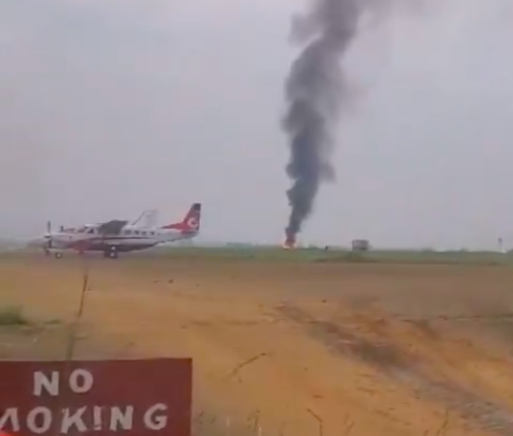DRC, January 24, 2024- In the conflict-ridden North Kivu region of the Democratic Republic of Congo, the use of alleged crash and downing of drones have become pivotal points in the ongoing narrative. Both sides of the conflict, the M23 rebels and the government-backed forces, have engaged in a sophisticated propaganda war, with the Rwandan government’s involvement also being a subject of contention.
There are circulating reports, primarily on social media, suggesting that a FARDC (Armed Forces of the Democratic Republic of the Congo) drone collided with a fire truck at Kavumu Airport near Bukavu. This incident is depicted as an accident involving a military drone.
Skepticism surrounds these claims, particularly in the absence of independently verified evidence. The lack of official confirmation or detailed reports from reliable news sources casts doubt on the veracity of this incident.
M23 spokesperson Willy Ngoma presented images that he claimed were of a downed FARDC drone in the Kibumba area. These images are purported to show the remnants of a CH-4 drone, allegedly shot down by M23 forces.
Resistance leaders, particularly from the Wazalendo group, contested these claims. They argue that the images shown by M23 are actually from a previous incident involving a MONUSCO helicopter, not a recent drone downing. Independent analysts have noted inconsistencies in M23’s presentation, questioning the absence of other drone parts and the lack of independent verification.
M23 has been actively using social media platforms to disseminate its narrative. This includes showcasing military victories, downplaying defeats, and promoting its leadership.
The group has been accused of manipulating images and events to bolster its claims, particularly regarding the drone incidents.
M23’s propaganda also extends to portraying the Rwandan government positively, often aligning their narratives with Kigali’s interests.
The Rwandan government is supporting M23’s propaganda efforts. This includes spreading narratives that favor M23’s stance and potentially discredit opposing forces.
Accusations against Rwanda include providing logistical and military support to M23, though Kigali has consistently denied direct involvement in the conflict.
The Congolese government and allied forces, including the Wazalendo, have launched their counter-narratives. These often involve discrediting M23’s claims, highlighting civilian casualties, and accusing Rwanda of regional destabilization.
The use of drones in this conflict and the subsequent claims of their downing are mired in a complex web of propaganda. Both sides have vested interests in controlling the narrative, often leading to exaggerated or unverified claims. The lack of independent verification makes it challenging to discern the truth behind these drone incidents. Additionally, the involvement of external actors like the Rwandan government adds layers of complexity to the information war, impacting regional dynamics and the perception of the conflict on the international stage.
This situation underscores the critical need for independent reporting and verification in conflict zones, where propaganda can significantly influence both local and international understanding of events.





























































